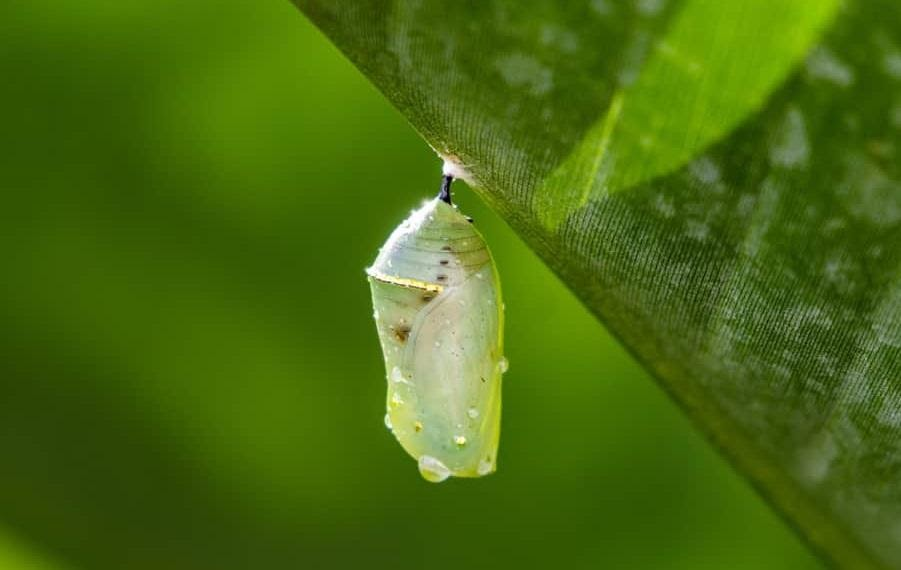
What is a cocoon?
Answer
491.1k+ views
Hint: Butterflies and moths are two of the most well-known insect cocoon builders. Caterpillars, which are their larvae, are ravenous eaters. Caterpillars make silk, which is then utilised to create the cocoon for the pupal stage of development, which is the last step before adulthood.
The terms pupa and chrysalis both refer to the stage of transition between the larva and the adult. While the term "pupa" can refer to either a butterfly or a moth's naked stage, the term "chrysalis" is reserved for the butterfly pupa. The silk casing that a moth caterpillar forms around itself before turning into a pupa is known as a cocoon.
Complete answer:
The protective covering made of silky threads that covers the larvae of moths and other insects such as butterflies is known as a cocoon. The cocoon is where the larvae develop into adult insects. The pupa is the stage of development that is protected by the cocoon. The pupa is also the stage that occurs between the larva and the adult.
The pupa of a moth is clothed in silk when it makes a cocoon, whereas the pupa of a butterfly is known as chrysalides and has no silk covering.
A chrysalis is the name given to the pupa of a butterfly. The pupa may be hanging under a branch, hidden in foliage, or buried underground, depending on the species. The pupa of many moths is kept safe inside a silk cocoon. They will become the adult butterfly's legs, wings, eyes, and other body components.
The cocoon is a silk-spun protective coating. The silkworm develops into a pupa, the intermediate stage between larvae and adult moths, inside the cocoon. - The pupa emerges from the cocoon as an adult moth after about two weeks. Before it is ready to spin its cocoon, a silkworm grows in size.

Note:
A pupa is a stage in the life cycle of various insects that transitions from immature to mature. Insects that go through the pupal stage are holometabolous, which means they go through four phases in their life cycle: egg, larva, pupa, and imago.
Hormones, particularly juvenile hormone, prothoracicotropic hormone, and ecdysone, regulate the process of entering and exiting the pupal stage. Pupation is the process of becoming a pupa, and eclosion or emergence is the process of emerging from the pupal case.
The pupae of different insect groups are given distinct names, such as chrysalis for butterfly pupae and tumbler for mosquito pupae. Pupae can also be found in cocoons, nests, and shells, among other structures.
The terms pupa and chrysalis both refer to the stage of transition between the larva and the adult. While the term "pupa" can refer to either a butterfly or a moth's naked stage, the term "chrysalis" is reserved for the butterfly pupa. The silk casing that a moth caterpillar forms around itself before turning into a pupa is known as a cocoon.
Complete answer:
The protective covering made of silky threads that covers the larvae of moths and other insects such as butterflies is known as a cocoon. The cocoon is where the larvae develop into adult insects. The pupa is the stage of development that is protected by the cocoon. The pupa is also the stage that occurs between the larva and the adult.
The pupa of a moth is clothed in silk when it makes a cocoon, whereas the pupa of a butterfly is known as chrysalides and has no silk covering.
A chrysalis is the name given to the pupa of a butterfly. The pupa may be hanging under a branch, hidden in foliage, or buried underground, depending on the species. The pupa of many moths is kept safe inside a silk cocoon. They will become the adult butterfly's legs, wings, eyes, and other body components.
The cocoon is a silk-spun protective coating. The silkworm develops into a pupa, the intermediate stage between larvae and adult moths, inside the cocoon. - The pupa emerges from the cocoon as an adult moth after about two weeks. Before it is ready to spin its cocoon, a silkworm grows in size.

Note:
A pupa is a stage in the life cycle of various insects that transitions from immature to mature. Insects that go through the pupal stage are holometabolous, which means they go through four phases in their life cycle: egg, larva, pupa, and imago.
Hormones, particularly juvenile hormone, prothoracicotropic hormone, and ecdysone, regulate the process of entering and exiting the pupal stage. Pupation is the process of becoming a pupa, and eclosion or emergence is the process of emerging from the pupal case.
The pupae of different insect groups are given distinct names, such as chrysalis for butterfly pupae and tumbler for mosquito pupae. Pupae can also be found in cocoons, nests, and shells, among other structures.
Recently Updated Pages
Master Class 12 Business Studies: Engaging Questions & Answers for Success

Master Class 12 Economics: Engaging Questions & Answers for Success

Master Class 12 English: Engaging Questions & Answers for Success

Master Class 12 Maths: Engaging Questions & Answers for Success

Master Class 12 Social Science: Engaging Questions & Answers for Success

Master Class 12 Chemistry: Engaging Questions & Answers for Success

Trending doubts
What are the major means of transport Explain each class 12 social science CBSE

Which are the Top 10 Largest Countries of the World?

Draw a labelled sketch of the human eye class 12 physics CBSE

How much time does it take to bleed after eating p class 12 biology CBSE

Explain sex determination in humans with line diag class 12 biology CBSE

Differentiate between homogeneous and heterogeneous class 12 chemistry CBSE




